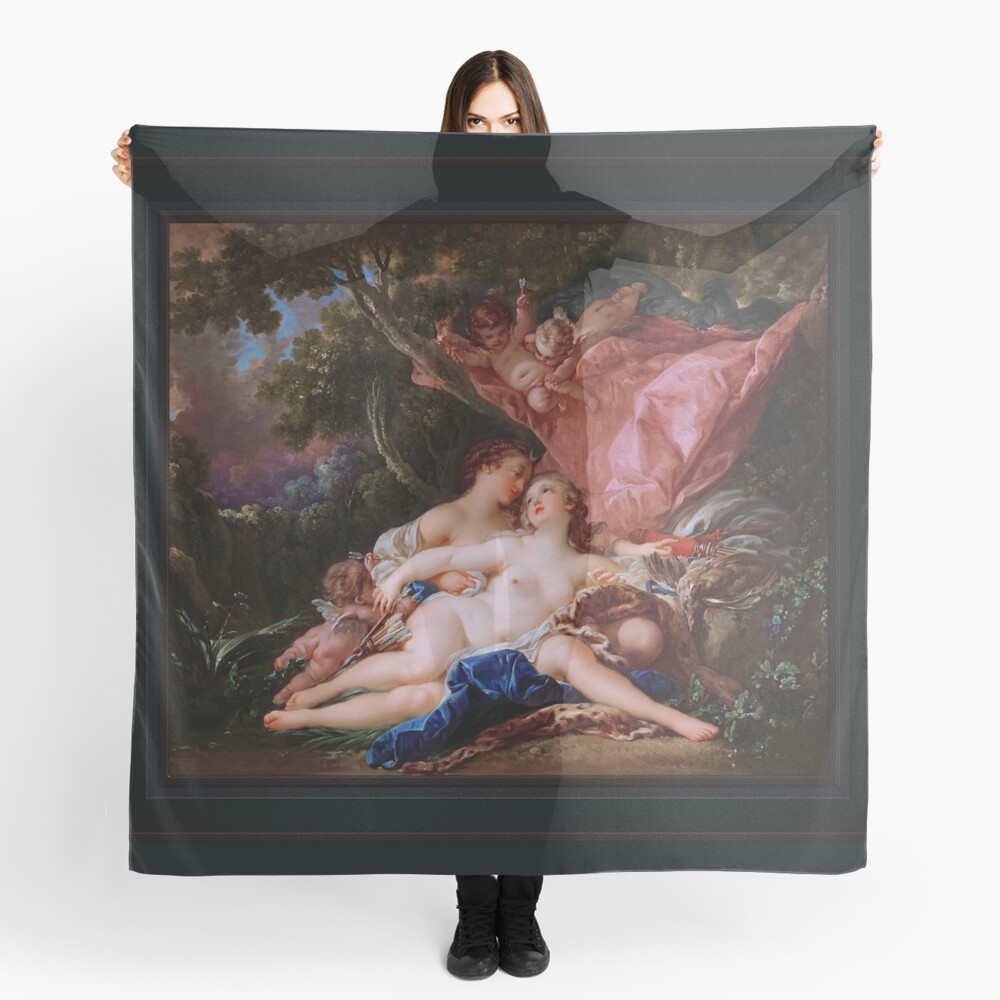
Jupiter in the Guise of Diana, and the Nymph Callisto
Jupiter in the Guise of Diana, and the Nymph Callisto c1759 by French Painter Françç Boucher (1703 – 1770); ka kilai talega me kena ivakatakata, ceuceu kei na iukuuku ena iwalewale ni French Ro qaqana, ka kilai levu ena nona vakabauta vakatatabu, allegorical and erotic motifs and was the court painter of Louis XV and a favorite of the Marquise de Pompadour.

This is a beautiful scene depicting the characters from Roman mythology Jupiter (The Eagle), Diana (Goddess of the Hunt), and Callisto the favorite Nymph of Diana.
In this forest scene we can see six figures, two cherubs in a tree with a large rose drape hanging from one of its outstretched limbs, near the eagle Jupiter looking down on what appears to be Diana and her Nymph Callisto, with one holding an arrow in his left hand; with another on the ground by the pond that Diana and her Nymph Callisto are laying near with an arrow in its left hand and a quiver filled with arrows by its right side.
Jupiter, the King of the Gods taken by the beauty of Callisto, disguises himself as the huntress Diana to seduce her; embracing her while they relax by the pond on a cushion of leaves, a blue garment and leopard skin.
By the couple is a boulder that has on it a brown bird resting on the chest of light colored bird that has had its throat cut, with blood staining the rock.
Behind the birds is a red quiver filled with arrows and a bow and another wrapped up grey colored garment, that rest just under the pink drape and the eagle Jupiter.

In the background is a colorful forest of many different hues and a light blue sky filled with many colored clouds, that seems to be illuminated by a setting sun.
Jupiter in the Guise of Diana, and the Nymph Callisto is a remastered digital art old masters reproduction of a public domain image that is available as a tabaki ni canvas ena initaneti.
iTukutuku e Ra e Vakaraitaka Mai Wikipedia.org
A native of Paris, O Boucher e luvena tagane e dua na dauboroboro lailai ka kilai levu o Nicolas Boucher, ka a solia vua na imatai ni nona vuli cakacaka ni liga. Ni yabaki tinikavitu, e dua na droini nei Boucher a qoroi mai vua na dauboroboro o Françelle Lemoyne. A qai lesi Boucher o Lemoyne me nona itaukei ni cakacaka, ia ni oti walega e tolu na vula, a laki cakacaka ena motoka nei Jean-Françç.
Ena 1720, a rawata na grand Grand-Rome ena droini, ia a sega ni taura na madigi me vulici e Itali me yacova ni oti e lima na yabaki, ena vuku ni leqa vakailavo ena Académie royale de de sculpture de.[1] Ena nona lesu mai ena vuli mai Itali a vakacurumi ki na ivakatakarakara matakau ni Académie de de 24 Noveba 1731. Na nona tekivutaka na nona morceau de (soqo ni ciqomi) a nona Rinaldo kei Armida ena 1734.

A vakamautaki Marie-Jeanne Carzeau o Boucher ena 1733. E tolu na luvedrau na veiwatini. A yaco o Boucher me dua na qasenivuli ena 1734 ka totolo sara na nona cakacaka mai na tikina oqo ena nona a tokoni Parofesa ena gauna oya ni Raitayaloyalotaki ni Academy, yaco me dauvakasaqaso ena Royal Gobelins Nasi kei Premier Peintre du Roi (iMatai ni Dauniboro ni Tui) ena 1765. Portrait of Marie-Louise O’Murphy c. 1752
A mate o Boucher ena 30 Me 1770 ena nona vanua o Parisi. Yacana, vata kei na nona petereni o Madame de Gasciu, sa yaco me tautauvata kei na iwalewale ni Roco Varanise, liutaki iratou na veitacini na Goncourt me ratou vola: “Boucher is one of those men who represent the taste of a century, o cei e vakaraitaka, matanataka ka vakaitovotaki keda.”
Boucher is famous for saying that nature is “trop verte et mal éclairée” (drokadroka sara ka waqa vinaka).
O Boucher a veimaliwai vata kei Jacques Guay ena vatu talei, o koya a vakavulica me droinitaka. A vakasalataka talega na kenadau o Moravian-Esitei o Martin Ferdinand, kei na dauboroboro ni neo-Louis David ena 1767.[4] E muri, A droinitaka o Boucher e so na droini ni cakacaka mai vei Guay ka a ceuti ka veisoliyaka o Madame de Toga ka veisoliyaki me vaka e dua na rorogo totoka ka totoka vei ira na dautuvatuva totoka



